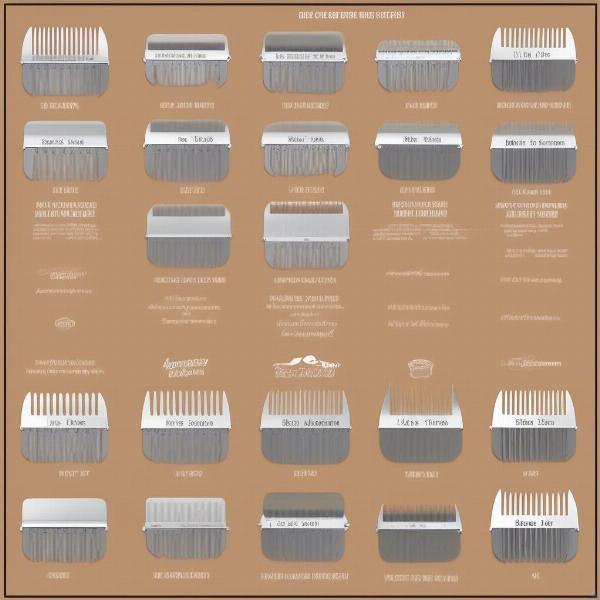Choosing the right dog hair clipper blades can be a daunting task, especially with the wide array available. Understanding the different types, sizes, and their specific uses is crucial for achieving a professional-looking groom at home and ensuring your dog’s comfort. This guide will cover everything you need to know about dog hair clipper blades, from identifying the right size for your dog’s breed and coat type to proper maintenance and cleaning techniques.
Understanding Dog Hair Clipper Blade Sizes and Types
Dog hair clipper blades are typically numbered, with lower numbers indicating longer cuts and higher numbers indicating shorter cuts. For instance, a #7 blade will leave the hair longer than a #10 blade. Recognizing these numbers is essential for achieving the desired coat length. Beyond the number system, blades also vary in material and style. Ceramic blades tend to stay cooler, reducing the risk of burns, while stainless steel blades are known for their durability. Skip tooth blades are designed for thinning thick coats, while finishing blades provide a smooth, polished look.
 Dog Clipper Blade Sizes Chart
Dog Clipper Blade Sizes Chart
Choosing the right blade size depends largely on your dog’s breed, coat type, and the desired style. For example, a #10 blade might be suitable for a close shave on a short-haired breed like a Beagle, while a #4F might be better for trimming the body of a Poodle. Using the wrong blade can lead to an uneven cut or even skin irritation.
Maintaining and Cleaning Your Dog Hair Clipper Blades
Proper maintenance and cleaning are essential for extending the life of your dog hair clipper blades. After each use, it’s important to brush away any hair and debris. Regularly oiling the blades keeps them running smoothly and prevents rust. dog clippers with vacuum can simplify the cleaning process by collecting loose hair.
Storing your blades properly is equally important. A blade guard protects the cutting edge and prevents accidental nicks. Storing the blades in a dry, cool place helps to prevent rust and corrosion.
Choosing the Right Blades for Different Coat Types
Different coat types require different blade types. For thick, double-coated breeds like Huskies or Malamutes, skip tooth blades can help thin the coat without shortening the length. For breeds with fine, silky coats like Yorkshire Terriers, finishing blades provide a smooth, polished finish. Understanding these nuances is critical for achieving the best results. wahl super groom dog clipper is a popular choice for a variety of coat types.
Which Blade Should I Use for a Close Shave on My Dog?
For a close shave, you’ll typically use a #10 blade or even a #40 surgical blade, depending on the area being shaved and your dog’s skin sensitivity. However, it’s important to exercise caution with these blades, as they can easily nick the skin. It’s best to consult a professional groomer or veterinarian for advice. trimmed briard dog provides a good example of a close trim.
What Blades are Best for Trimming Paws and Face?
For delicate areas like the paws and face, a #15 or #30 blade is often recommended. These blades provide a closer trim without being as harsh as a #10 or #40 blade. silent dog trimmers are ideal for these sensitive areas as they minimise noise and vibration, reducing stress for your dog.
Conclusion
Choosing the correct dog hair clipper blades is crucial for achieving a professional-looking groom and ensuring your dog’s comfort. By understanding the different blade sizes, types, and their specific uses, you can confidently trim your dog’s coat at home. Remember to prioritize proper maintenance and cleaning to prolong the life of your blades and always consult a professional if you’re unsure about which blade to use. best dog clippers for shih tzu offers more specific advice for certain breeds.
FAQ
- How often should I replace my dog hair clipper blades? Blades typically need replacing when they become dull, usually after several uses depending on the frequency of grooming and proper maintenance.
- Can I use human hair clipper blades on my dog? It’s not recommended to use human hair clipper blades on dogs, as they are not designed for animal fur and can cause skin irritation.
- What is the difference between skip tooth and finishing blades? Skip tooth blades are designed for thinning thick coats, while finishing blades create a smooth, polished look.
- How do I know if my clipper blades are dull? Dull blades will pull at the hair instead of cutting it smoothly, potentially causing discomfort for your dog.
- How do I prevent my clipper blades from overheating? Using clipper coolant and taking breaks during grooming can help prevent overheating.
- What should I do if I accidentally cut my dog’s skin while clipping? Apply pressure to stop the bleeding and consult a veterinarian if necessary.
- Where can I buy replacement blades for my dog clippers? Replacement blades can be purchased online, at pet stores, or from grooming supply stores.
About ILM Dog: ILM Dog is your trusted international resource for expert advice on dog care and grooming, covering everything from breed selection to health, training, and product reviews. We offer practical tips and guidance for dog owners of all experience levels. Whether you’re looking for the best dog clippers for a specific breed or need advice on dog nutrition, ILM Dog is here to help. Contact us at [email protected] or +44 20-3965-8624 for personalized advice.